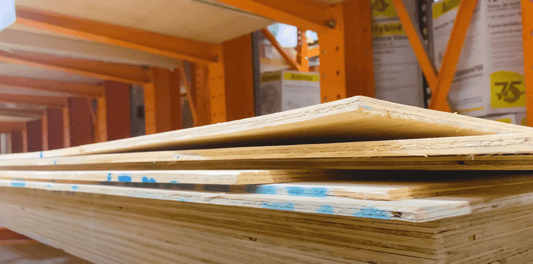
Track Saw Model: RIDGID 18v
Share
Wittworks Track Saw Rating: 74 out of 100
Ridgid Track Saw Review: Solid Build, But Misses the Mark
Track saws are often the go-to tool for making precise, clean cuts in wood, especially when cutting long panels. The Ridgid track saw enters the market with a lot of promise, boasting solid build quality and a well-designed track. But, when it comes to performance, especially under heavy use, this tool falls short in some critical areas. Let’s break down what works and where the Ridgid track saw misses the mark.
Fit & Finish: Rock Solid Build
Score: 10/10
Right out of the box, the Ridgid track saw impresses with its build quality. It feels solid and substantial in hand—nothing about it feels cheap. The high-quality materials and sturdy construction make it clear that Ridgid prioritized durability in the design. Whether you're a DIYer or a pro, the fit and finish of this saw will leave you feeling confident.
Blade: Functional, But Not Outstanding
Ease of Blade Change: 2/3
Changing blades is straightforward and easy.
Stock Blade: 1/2
The stock blade does the job, but it’s nothing to write home about. You may want to swap it out for a better one if you’re planning to tackle more demanding cuts.
Blade Size & Arbor: 6 ½” Blade, ⅝” Arbor
The Ridgid track saw doesn’t use the standard 165mm blade with a 20mm arbor (the hole size in the middle). Instead, it uses a typical 6.5” circular saw blade with a ⅝” arbor. These blades are less expensive compared to track saw blades and are readily available at home centers, which is why Ridgid did this.
Safety: Strong Features
Riving Knife/Anti Kickback: 5/5
One of the standout features of the Ridgid track saw is its riving knife, which operates independently from the saw blade. This ensures that the riving knife doesn’t extend beyond the blade, allowing you to plunge cut with the riving knife.
Off-Cut Splinter Guard: 0/1
There’s no splinter guard included, which means you’ll get some tear-out on your offcuts, especially when working with plywood or veneer.
Scoring Function: 1/1
The scoring function works well, helping to reduce splintering when making plunge cuts.
Depth Gauge: Decent, But Missing Fine Adjustments
Accuracy: 2/2
The depth gauge is spot-on and accurate.
Fine Tune Adjustment: 0/2
There is no fine-tune adjustment, which is a noticeable drawback.
User Experience: 3/3
The depth gauge overall is easy to use, and one of my favorites. You can adust quickly with one hand. I also appreciate a clear depth scale that’s easy to read. The lack of fine-tune adjustments doesn’t drastically impact the user experience for most casual woodworkers.
Dust Extraction: Underwhelming Performance
Hose Compatibility: 1/3
The Ridgid saw doesn’t fit the popular Festool or Centec hoses, which could be a dealbreaker for those who have invested in those dust collection systems or hoses. We do sell a replacement port here.
Effectiveness: 1/3
The dust extraction is one of the weakest points of this saw. While it does vacuum up some dust, it’s nowhere near as effective as higher-end models, leaving a mess on your work surface and floor.
Bevel Cutting: A Mixed Bag
Readability/Detents for Common Angles: 4/4
The detents for common bevel angles (like 22.5° and 45°) are clear and easy to read, making bevel cutting simpler.
Return to 90: 5/5
Returning to 90 degrees is easy and accurate. There’s no issue getting a square cut after adjusting the bevel angle, which is a big plus for precision work.
Anti-Tip: 2/2
The saw has a solid anti-tip mechanism, helping to stabilize it during angled cuts.
Track Friction Adjustments: 3/3
The saw’s friction adjustments for the guide rail are smooth and reliable, making it easy to get straight, precise cuts without slop in the base.
Motor: Underpowered for Heavy Duty
Variable Speed: 0/2
The Ridgid track saw lacks variable speed settings. This is a disadvantage when you need to adjust the speed for different materials.
Sound & Feel: 4/5
The saw has a solid feel and decent sound. It’s not too loud or weak, but it’s not as powerful as some higher-end models.
2” Hard Maple Test: 1/5
The saw failed to complete the 2” hard maple test with the stock blade, the battery overheated and caused the tool to shut down. Obviously, you would not want to perform a single 2” pass ripping cut on hardwood with a cross cut blade, but it should be noted that this pushed the battery and or motor to the limit. When we performed the same cut with a ripping blade, the motor and battery did fine. I’ve not encountered this failure on any other track saw to date.
Track: Solid, but Not Perfect
Build Quality: 5/5
The track itself is well-built, with high-quality materials and a sleek black finish. It’s sturdy and durable, making it easy to work with.
Design Profile: 2/4
The track profile could have been better by complying with the standard profile of most other guide rails.
Size Options: 2/3
Ridgid offers two sizes: 27.5 and 60”. I would like to see a 108” option.
Rubber Splinter Guard Stickiness: 3/3
The splinter guard is nice and sticky, helping to prevent splinters on your cuts.
Anti-Slip Grips: 1/3
The anti-slip grips are disappointing. You’ll likely need to clamp the track down for better stability.
Clamp Compatibility: 2/2
The track is fully compatible with typical track saw clamps, which helps hold it in place during cuts.
3rd Party Accessory Compatibility: 4/4
Unlike the Ryobi, the Ridgid track is compatible with a wide range of third-party accessories, expanding your options for customization.
Warranty: Solid Coverage
Score: 5/5
Ridgid offers a Life Time Service agreement with all of their tools, which is a reassuring factor if you’re investing in the tool. This warranty is one of the best in the industry and reflects the brand’s confidence in its product.
Price / Value: A Tough Sell
Score: 5/10
The Ridgid track saw feels well-built, but it struggles to justify its $440 price tag (tool-only). The performance issues—especially the battery overheating and lack of variable speed—make it hard to recommend at this price. If you’re looking for more power or features, there are better options available in the same price range.
Who is this Saw For?
It’s hard to pinpoint a clear audience for the Ridgid track saw. While it has some solid features—especially its build quality and safety mechanisms—it’s ultimately outclassed by other track saws in the same price range. Unless you’re particularly attached to the Ridgid brand or don’t want to add another battery platform to your shop, you’ll probably find better value elsewhere.
Who Should NOT Buy This Saw?
Most people would be better off with a different track saw. While the Ridgid track saw has its moments, it’s lacking in key areas like dust extraction and power. If you’re serious about woodworking or need a tool that can handle both sheet goods and dense hardwoods without overheating, you might want to consider other options.
Final Thoughts:
The Ridgid track saw is a tool that promises a lot but ultimately doesn’t deliver enough to stand out in a crowded market. While it’s built like a tank and has a solid track system, its motor limitations, lack of variable speed, and poor dust extraction hold it back. If you're looking for a reliable, versatile track saw, there are better choices out there for the same—or even a lower—price. If Ridgid can improve on the motor and battery system, and lower the price point, than this would make for one of the best value track saws.




